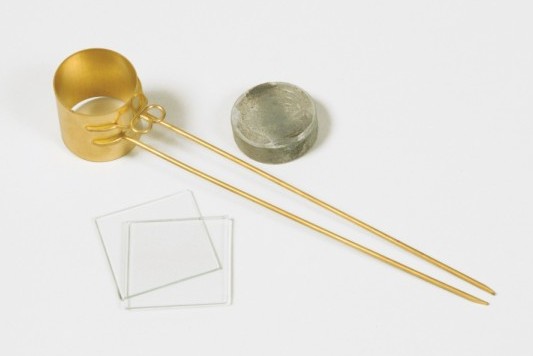
Soundness of cement is carried out to detect the presence of uncombined lime in cement. This test is performed with the help of Le-chatelier apparatus.
LE- CHATELIER APPARATUS:
 It consist of a brass mould of diameter 30 mm and height 30 mm. There is a split in mould and it does not exceed 0.50 mm. On either side of split there are two indicators with point ends. The thickness of mould cylinder is 0.50 mm.
It consist of a brass mould of diameter 30 mm and height 30 mm. There is a split in mould and it does not exceed 0.50 mm. On either side of split there are two indicators with point ends. The thickness of mould cylinder is 0.50 mm.
OTHER APPARATUS USED:
1. Balance
2. Measuring Box
3. Caliper
4. Water Bath
5. Glass Sheets
6. Enamel Tray
7. Trowel
PROCEDURE:
- Prepare a paste of cement by adding 0.78 times the water required to give a paste of standard consistency.
- Lightly oil the Le-chatelier mould and place it on lightly lightly oiled glass sheet.
- Fill the mould with prepared cement paste. In the process of filling the mould keep the edge of the mould gently together.
- Cover the mould with another piece of lightly oiled glass sheet, place a small weight on this covering glass sheet.
- Submerge the whole assembly in water at a temperature of 27±2°C and keep there for 24 hours.
- Remove the whole assembly from the water bath and measure the distance separating the indicator points to the nearest 0.5 mm (L1).
- Again submerge the whole assembly in water bath and bring the temperature of water bath to the boiling temperature in 25 to 30 minutes. Keep it at boiling temperature for a periods of 3 hours.
- After completion of 3 hours allow the temperature of the water bath to cool down to room temperature and remove the whole assembly from water bath.
- Measure the Distance between the two indicator point s to the nearest 0.5 mm (L2).
CALCULATIONS:
Soundness of cement= L1 - L2
L1 = Measurement taken after 24 hours of immersion in water at a temperature of 27±2°C
L2= Measurement taken after 3 hours of immersion in water at boiling temperature.
IS:4031 (Part 3):1988


